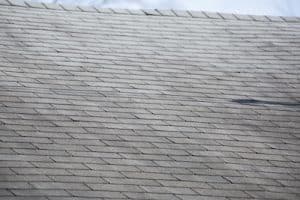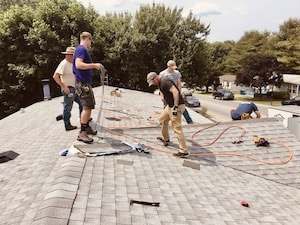There is no question that the roof of your home plays a crucial role in protecting both the structural integrity of your house and the safety of your family. Unfortunately, roof damage that goes unnoticed may result in expensive emergency roofing repairs. Keeping an eye on the condition of your roof is the best way to catch minor damage before it is too late. One thing that homeowners may notice while inspecting their roof is that the roof appears wet even on a sunny day.
Why does my roof look wet? While there are several reasons why your roof may appear to be wet, it is likely caused by algae growing on your shingles. Often appearing as dark streaks, roof algae is easily mistaken as wet patches. The wet appearance of your roof could also be caused by rotting shingles that are holding water for long periods of time.
No matter what the cause, if your roof looks wet it is important to schedule a professional roof inspection. Even a less invasive issue like algae can quickly escalate to a more serious form of roof damage. In this post, we will discuss how to reverse early signs of roof damage such as the appearance of wet shingles through proper roof maintenance.

What to Do If Your Roof Looks Wet
You likely came to this post because your roof appears wet, even without the presence of precipitation. This is a common problem, especially on older roofs, and can provide you with great insight into the condition of your shingles.
In most cases, shingles appear wet because they are covered with a type of algae. This problem typically begins as small spots on the roof, eventually becoming large black streaks. So, how does the algae form in the first place? What does this mean for the overall condition of your roof?
If you are noticing streaks of algae on your roof, you will likely observe them on the north side of your house. This is not a coincidence. Algae thrives in cool, shaded areas. When a certain area of your roof is shaded, moisture begins to accumulate. As a result, airborne algae spores begin to congregate.
Other common contributors to algae growth on the roof include gutters that drain onto the shingles as well as trees that hang over the roof. Both of these situations encourage the presence of shade and moisture, encouraging algae to form.
Do I Need to Remove Algae From My Roof?
The presence of algae on your roof is not something to cause concern. However, it should be removed in a timely manner. Over a period of time, algae on your roof will cause the UV granules that protect your shingles to come off. This will cause your shingles to dry out, eventually forcing you to replace the roof.
Additionally, algae often travels with a friend. Certain types of fungus are known to congregate on roofs where algae is thriving. Unlike algae, fungus can form into a lichen which can quickly develop roots. As you can imagine, remediating this problem is much more involved than removing algae alone.
Removing Roof Algae
Luckily, removing the algae that is causing your roof to look wet is actually quite simple. A simple roof cleaning will remove any algae that has begun to form, leaving a clean, fresh roof behind.
While this may seem like the perfect opportunity for a DIY project, it is important to note that cleaning your roof on your own could result in serious implications. A DIY roof cleaning may void your roof warranty or even your homeowner’s insurance. For these reasons, as well as the danger of cleaning a roof, it is important to work with a professional roofing company for this service.
Unfortunately, removing algae from your roof is not a one-time event. In many situations, algae will eventually form in the same areas, due to the presence of shade and moisture accumulation. To prevent this from happening, you may consider rerouting any gutters or removing tree limbs that contribute to an algae-friendly environment.
Rotting Shingles Make Your Roof Look Wet
If algae is not present, your roof may look wet because of rotting shingles. This is a much more serious problem that must be addressed immediately. Rotting shingles will hold onto excess water long after it rains, causing portions of your roof to appear wet while the majority of your roof is dry.
Different from algae or fungus, moss will often begin to form on shingles that are water-logged or beginning to rot. Rotting shingles are almost always a sign that your roof is in need of immediate repair and should be handled accordingly.
Working with a residential roofing company in Tulsa is the best way to determine the cause of your roofing woes and reach a solution.
 Inspecting Your Roof for Damage
Inspecting Your Roof for Damage
As a homeowner, it is a good idea to regularly inspect your roof for signs of damage. While you are not able to get a complete picture of the condition of your roof from ground level, it will provide you with an idea of how well your roof is holding up.
For most homes, you can simply walk around the exterior of your home to get a good look at the roof from several angles. It may help to look at your roof from across the street to get a more comprehensive idea of the overall condition.
Once you have inspected the overall roof condition from a distance, walk around the exterior of your home, inspecting the guttering. You should also inspect the interior of your home for signs of roof damage such as water leaks in the attic or upper floor of your home.
It is also recommended to have your roof regularly inspected by a professional roofing company at least once every few years. If you live in an area like Oklahoma, with a wide variety of intense weather events, it is wise to schedule a professional roof inspection once each year.
Regularly inspecting your roof is the best way to discover early warning signs of damage, allowing you to address the issue before it escalates into something more complex. Making this a priority will save you time, frustration, and possibly thousands of dollars.
Other Warning Signs of Roof Damage
There are many other warning signs of roof damage. Many of these issues, if caught in their early stages, are easily remedied. However, if left unaddressed, they can cause more intense roof damage, requiring you to replace the entire roof.
Missing Shingles
While one missing shingle may not seem like a cause for concern, a missing shingle can create significant problems. A missing shingle creates the potential for damage to spread to the surrounding shingles. Not only that, depending on its location, but a singular missing shingle can also even lead to a water leak that damages the inside of your home!
You can read more about what causes missing shingles here.
Warped Shingles
Another sign that roof repair or replacement is in your future is the presence of warped shingles. Warped shingles are caused by repeated exposure to weather damage. When a shingle begins to curl up at the edges, it could be a sign that they are either rotting or drying out. Both of these issues can lead to a missing shingle or further roof damage.
There are many other warnings signs of roof damage. Educating yourself on the situations requiring professional attention from a residential roofing company will eliminate a roofing emergency.
For more information, read this article on how to tell if it’s time for a new roof.
Proper Roof Care & Maintenance
Proper roof care and maintenance is the best way to eliminate problems with your roof that would require professional intervention. A few of the things you can do to take care of your roof include the following:
Remove Debris
Dead leaves, sticks, and other debris that sit on your roof will create the perfect damp environment for pests and mold to form. It is important to remove any debris you notice accumulating on your roof! If the roof of your home is slanted appropriately, this should not be a huge concern.
However, homeowners with a flat roof or a roof that is only slightly slanted will need to remove debris on a more regular basis.
Take Care of Your Guttering
The condition of your gutters can impact your shingles! When your gutters become clogged or begin to overflow, water and yard debris begin to accumulate on your shingles. Make sure you are cleaning your gutters regularly and rerouting any gutters which flow directly onto your roof. Doing so will not only protect the condition of your roof but also other structural elements of your home.
Replace Your Roof When Necessary
Replacing your roof is not an inexpensive feat. However, in some cases, it is absolutely necessary. If your roof has experienced extreme damage or even expected wear and tear, it may be time to consider replacing your roof. This will not only protect the investment in your home but will also reduce the possibility of emergency roof repairs.
Thank you for reading Expert Home Report! Learn more about home maintenance from experts here
